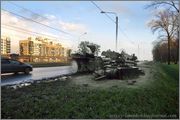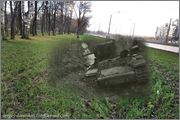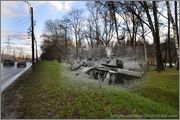The Big Surprise, June 23 1941, Dubissa River.
It is June 1941 and the Soviet army is not fairing well since the Germans had started their Eastern offensive, smashing into the Soviet lines and racing for the main goal of Moscow. Although the days were indeed dark for the soldiers of the Soviet Army, there was a Ace card up the sleeve of the Soviet armored forces, which readying itself to strike a blow to the beast knocking at the door.
The Ace card... the mighty KV-1 heavy tank, a very modern and sleek armored fist that was just itching to get into the fray and make it's name known on the battlefield.
On the ground things went almost as bad (for the Soviets) as in the air, with Army Group North (Leeb) making rapid progress across the Baltic States. On 22nd June the 56th Panzer Corps (von Manstein) pierced the Soviet 8th Army’s northern flank and advanced rapidly to the Dubissa River, where it seized a crossing on the Airogola viaduct. 56th Panzer Corps’ immediate objective was to secure a crossing on the Dvina River; hopefully at Daugavpils.
The German commander General Reinhard recalled their surprise.
One hundred of our tanks, about a third of them Panzer IV, occupied their positions against a counter-strike. Part of our forces met the enemy frontally, but most of them were on their flanks. They hit the steel monsters from the three sides, but the attempts to destroy them were unsuccessful. By the contrary, it was our tanks which were knocked out. After a long struggle with the Soviet giants, the German armoured units began to withdraw trying to avoid the annihilation.
One of the KVs got close to a panzer who was stuck in a muddy brook. Without hesitation, the black monster just roll over it, crushing it completely.
Then a German 105 mm howitzer arrived. Its commander, seeing the mass of enemy tanks, ordered continuous firing, but without causing any damage. One of the KVs got close, to within 100m of the howitzer, which fired again, and its shell hit the tank full on. The tanks stopped as if hit by lightning. “We made it!” thought the gunners. “Yes, we made it!!!”, shouted the commander of the position.
But the expresson in their faces suddenly changed when one of them shouted: “It’s moving again!!”. There was no doubt – the shiny caterpillar moved up to the howitzer and crushed it like a toy, then kept on moving as if nothing had happened.



Thuringian 1st Panzer Division describes this battle.
The KV-1 & KV-2, which we first met here, were really something! Our companies opened fire at about 800 yards, but it remained ineffective. We moved closer and closer to the enemy, who for his part continued to approach us unconcerned.
Very soon we were facing each other at 50 to 100 yards. A fantastic exchange of fire took place without any visible German success. The Russian (sic - Soviet) tanks continued to advance, and all armour-piercing shells simply bounced off them. Thus we were presently faced with the alarming situation of the Russian tanks driving through the ranks of 1st Panzer Regiment towards our own infantry and our hinterland.
Our Panzer Regiment therefore about turned and rumbled back with the KV-1s and KV-2s, roughly in line with them. In the course of that operation we succeeded in immobilizing some of them with special purpose shells at very close range 30 to 60 yards. A counter attack was launched and the Russians were thrown back. A protective front established & defensive fighting continued.
Links...
http://ww2today.com/23rd-june-1941-the-germans-encounter-the-kv1
http://www.operationbarbarossa.net/the-northern-sector/
http://en.wikipedia.org/wiki/Battle_of_Raseiniai
It is June 1941 and the Soviet army is not fairing well since the Germans had started their Eastern offensive, smashing into the Soviet lines and racing for the main goal of Moscow. Although the days were indeed dark for the soldiers of the Soviet Army, there was a Ace card up the sleeve of the Soviet armored forces, which readying itself to strike a blow to the beast knocking at the door.
The Ace card... the mighty KV-1 heavy tank, a very modern and sleek armored fist that was just itching to get into the fray and make it's name known on the battlefield.
On the ground things went almost as bad (for the Soviets) as in the air, with Army Group North (Leeb) making rapid progress across the Baltic States. On 22nd June the 56th Panzer Corps (von Manstein) pierced the Soviet 8th Army’s northern flank and advanced rapidly to the Dubissa River, where it seized a crossing on the Airogola viaduct. 56th Panzer Corps’ immediate objective was to secure a crossing on the Dvina River; hopefully at Daugavpils.
The German commander General Reinhard recalled their surprise.
One hundred of our tanks, about a third of them Panzer IV, occupied their positions against a counter-strike. Part of our forces met the enemy frontally, but most of them were on their flanks. They hit the steel monsters from the three sides, but the attempts to destroy them were unsuccessful. By the contrary, it was our tanks which were knocked out. After a long struggle with the Soviet giants, the German armoured units began to withdraw trying to avoid the annihilation.
One of the KVs got close to a panzer who was stuck in a muddy brook. Without hesitation, the black monster just roll over it, crushing it completely.
Then a German 105 mm howitzer arrived. Its commander, seeing the mass of enemy tanks, ordered continuous firing, but without causing any damage. One of the KVs got close, to within 100m of the howitzer, which fired again, and its shell hit the tank full on. The tanks stopped as if hit by lightning. “We made it!” thought the gunners. “Yes, we made it!!!”, shouted the commander of the position.
But the expresson in their faces suddenly changed when one of them shouted: “It’s moving again!!”. There was no doubt – the shiny caterpillar moved up to the howitzer and crushed it like a toy, then kept on moving as if nothing had happened.



Thuringian 1st Panzer Division describes this battle.
The KV-1 & KV-2, which we first met here, were really something! Our companies opened fire at about 800 yards, but it remained ineffective. We moved closer and closer to the enemy, who for his part continued to approach us unconcerned.
Very soon we were facing each other at 50 to 100 yards. A fantastic exchange of fire took place without any visible German success. The Russian (sic - Soviet) tanks continued to advance, and all armour-piercing shells simply bounced off them. Thus we were presently faced with the alarming situation of the Russian tanks driving through the ranks of 1st Panzer Regiment towards our own infantry and our hinterland.
Our Panzer Regiment therefore about turned and rumbled back with the KV-1s and KV-2s, roughly in line with them. In the course of that operation we succeeded in immobilizing some of them with special purpose shells at very close range 30 to 60 yards. A counter attack was launched and the Russians were thrown back. A protective front established & defensive fighting continued.
Links...
http://ww2today.com/23rd-june-1941-the-germans-encounter-the-kv1
http://www.operationbarbarossa.net/the-northern-sector/
http://en.wikipedia.org/wiki/Battle_of_Raseiniai





